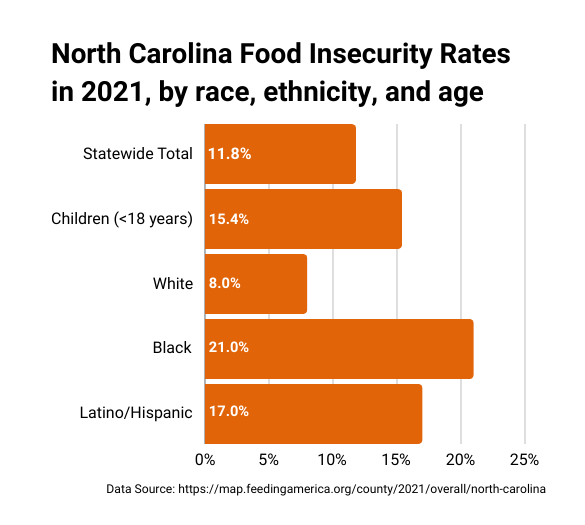Food Security in North Carolina
Emerging Voices Blog Series

By Brodie Smith
The Emerging Voices blog features stories from IEI interns, students from across the state and other up-and-coming voices about issues that matter to North Carolinians.
Most of us have opted-out of eating lunch at a restaurant or decided to make coffee at home to save some money. However, for some in North Carolina it is a challenge to consistently provide food for themselves and their loved ones while also meeting various other financial demands, such as paying rent or seeking healthcare. How much we spend and allocate on obtaining food is often seen as a variable expenditure, one that we sometimes decide to spend less on if we come across an obstacle that puts us through financial stress. Food insecurity is something that people all across the globe endure, and it can have major impacts on an individual’s health and well-being.
That’s about one in every eight people facing limited access to nutritionally-adequate food in our state.
The U.S. Department of Agriculture defines food insecurity as “the limited or uncertain availability of nutritionally adequate and safe foods, or limited or uncertain ability to acquire acceptable foods in socially acceptable ways.” Essentially, food insecurity is the lack of access to food that is both nutritious and safe, and while the degree to which individuals experience food insecurity vary, the effects still impact people in a multitude of ways. In 2021, the population of food insecure individuals in North Carolina was more than 1.2 million, at a rate of 11.8%. That’s about one in every eight people facing limited access to nutritionally-adequate food in our state.
Food insecurity disproportionately affects different populations, and this is evident in North Carolina where race, ethnicity and age all play into the rate at which you acquire food.

White individuals in North Carolina were exposed to food insecurity at a statewide rate of 8%, with no county having a rate higher than 14%. Latino and Hispanic individuals were food insecure at a rate of 17% across North Carolina, with no counties reporting a rate below the statewide overall average. For Black individuals, the rate of food insecurity was 21%, nearly double that of the statewide overall average. Additionally, in 31 rural counties across North Carolina this rate was 24% or higher for Black individuals, with Hyde County having a food insecurity rate of 39%. Children under the age of 18 experienced food insecurity at a rate of 15.4% in 2021, and there were 16 counties where about one in every four children were food insecure.
…there were 16 counties where about one in every four children were food insecure.
Households in the United States with children already face a higher rate of food insecurity than the national average, yet these households in our nation’s rural communities face a much larger rate of food insecurity, with approximately 19.7% suffering from low to very low food security. When individuals, especially children who are progressing through some of the most important developmental stages of their lives, are unable to access the nutritionally-adequate foods they require for healthy growth, they may be subjected to health and developmental implications that could last well into adulthood.
We know that when people experience food insecurity, they face a multitude of challenges that can affect their family dynamics, personal health and mental well-being, but what can be done to support these individuals in their mission to feed their loved ones?
Multiple studies have shown that participation in food assistance programs, such as SNAP or WIC, can help mitigate the adverse effects of household food insecurity and provide nutritionally-adequate food to keep families fed. However, not all those who are eligible for these food assistance programs access the benefits; in 2019, North Carolina only reached about 85% of the SNAP-eligible population and about 54% of the WIC-eligible population. During the COVID-19 pandemic, the WIC and SNAP food assistance programs were expanded to support Americans who were suffering from food insecurity due to the pandemic. These expansions ended August 1, 2023.
While we may not have the power to change policy or expand food assistance programs overnight, there are still things that we can do to support those who are struggling with food insecurity in North Carolina. In our state, we have seven food banks that work tirelessly to provide food for North Carolinians who are experiencing hunger, and there are many ways that you can support these organizations. Through volunteering at a local food bank or donating to one of the various organizations, you can have a direct impact on food insecurity in your community.
To find out more about food banks that serve your community and ways that you can support them, check out Feeding America’s website.
- Categories:


